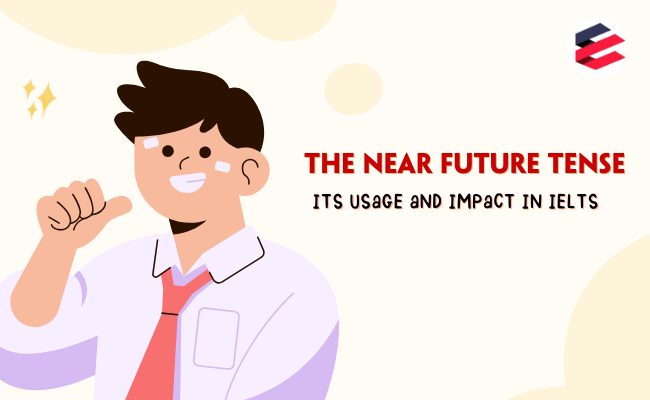The Near Future Tense: A Guide to Its Usage and Impact in IELTS
The English language offers various tenses that allow us to express actions and events in different time frames. One such important tense is the near future tense, which enables us to discuss actions that will happen shortly. Understanding the structure, usage, and impact of the near future tense is essential for effective language expression, particularly in the context of language proficiency exams like the IELTS. In this essay, we will explore the near future tense, its formation, usage, and how it influences one’s performance in the IELTS exam.

1. What is the near future tense?
The near future tense, also known as the “going to” future tense, is a grammatical structure used to express future actions that are planned, intended, or likely to happen in the near future. It is employed to discuss events that are just about to occur or are anticipated shortly.
2. How to use the near future tense?
Using the near future tense, often referred to as the “going to” future tense, is fairly straightforward and is employed to discuss future actions, plans, intentions, or predictions. Here’s a step-by-step guide on how to use the near future tense:
2.1. Form the Near Future Tense Structure
Start by constructing the basic structure of the near future tense. The structure involves:
- The subject (I, you, he, she, it, we, they)
- The appropriate form of the verb “to be” (am, is, are)
- The phrase “going to”
- The base form of the main verb (infinitive)
2.2. Choose the Correct Form of “to be”
Select the correct form of the verb “to be” based on the subject of the sentence:
- I am
- You are
- He/She/It is
- We/They are
2.3. Add “Going To”
Add the phrase “going to” after the appropriate form of the verb “to be”:
- I am going to
- You are going to
- He/She/It is going to
- We/They are going to
2.4. Use the Base Form of the Main Verb
Append the base form of the main verb (infinitive) after “going to” to convey the intended action or event:
- I am going to visit my friend tomorrow.
- They are going to study for the exam.
2.5. Form Negative Sentences
To create negative sentences in the near future tense, add “not” after “going to”:
- I am not going to visit my friend tomorrow.
- They are not going to study for the exam.
2.6. Form Interrogative Sentences
In questions, invert the subject and the appropriate form of “to be”:
- Am I going to visit my friend tomorrow?
- Are they going to study for the exam?
2.7. Use for Predictions, Plans, and Intentions
Utilize the near future tense to discuss actions, plans, or intentions that will happen in the near future:
- I am going to buy a new car next month.
- She is going to start her new job next week.
- We are going to travel to Europe next year.
2.8. Use for Certainties Based on Evidence
You can also use the near future tense to express something that is certain to happen based on present evidence or circumstances:
- Look at those dark clouds; it’s going to rain soon.
- She’s so well-prepared; she’s going to ace the exam.
By following these steps and guidelines, you can effectively use the near future tense to communicate future actions, plans, predictions, and intentions in a clear and accurate manner.
>> Suggested article: the future simple
3. How does the near future tense form?
The near future tense is formed using a structure where the subject is followed by the phrase “am/are/is going to” and the base form of the verb (infinitive). The structure is as follows:
3.1. Affirmative
Subject + am/are/is + going to + base form of the verb (infinitive)
3.2. Negative
Subject + am/are/is + not + going to + base form of the verb (infinitive)
3.3. Interrogative
Am/Are/Is + subject + going to + base form of the verb (infinitive)

4. How does the near future tense impact the IELTS test?
The near future tense, often referred to as the “going to” future tense, holds a significant impact on the International English Language Testing System (IELTS) test. Demonstrating an accurate and appropriate use of this tense is crucial for mastering the grammar for IELTS as well as achieving a higher score in the exam. Here’s how the near future tense impacts the IELTS:
4.1. Expressing Future Plans and Intentions
In both the speaking and writing sections, test takers are frequently asked about their future plans, goals, and intentions. Utilizing the near future tense allows candidates to articulate these plans clearly and precisely, demonstrating their language proficiency and ability to discuss future actions in an organized manner.
4.2. Discussing Future Predictions
The IELTS test often assesses a candidate’s ability to make predictions about future events, trends, or circumstances. The near future tense is vital for accurately expressing these predictions, showcasing one’s understanding of future occurrences based on present observations or knowledge.
4.3. Enhancing Language Complexity
Employing the near future tense in both spoken and written responses adds complexity and sophistication to the language. It showcases a broader range of grammatical structures and demonstrates a higher level of language proficiency, which positively influences the examiner’s perception of the candidate’s abilities.
4.4. Highlighting Grammatical Range
The effective use of the near future tense contributes to showcasing a wide range of grammatical structures and tenses. This is a key criterion in the IELTS assessment, and using the near future tense appropriately reflects a candidate’s versatility in manipulating different grammatical forms.
4.5. Improving Coherence and Cohesion
Proper application of the near future tense aids in creating well-structured and coherent responses, especially in the writing section. It allows for a logical and organized discussion of future-related topics, contributing to a higher score in the coherence and cohesion criterion.
4.6. Relevant in Various Task Types
The near future tense is applicable across different task types in the IELTS test, including describing trends, proposing solutions, giving advice, or discussing hypothetical situations. Mastery of this tense allows for effective communication in these diverse contexts.
4.7. Accuracy and Language Precision
Using the near future tense accurately and appropriately demonstrates grammatical accuracy and language precision. It reflects a candidate’s ability to convey future-related ideas with clarity and correctness, aligning with the assessment criteria of the IELTS test.

5. Sample question for the near future tense
Exercise 1: Rewrite the sentences using the near future tense (going to).
- I will visit my friend tomorrow.
=> I am going to visit my friend tomorrow.
- They will study for the exam.
=> They are going to study for the exam.
Exercise 2: Create a sentence using the near future tense (going to). Choose the correct verb and form it accordingly.
- She / travel to Paris
=> She is going to travel to Paris.
- We / have a party
=> We are going to have a party.
Exercise 3: Form negative sentences using the near future tense (going to).
- I will complete the assignment.
=> I am not going to complete the assignment.
- They will attend the meeting.
=> They are not going to attend the meeting.
Exercise 4: Ask questions using the near future tense (going to).
- He / study for the test
=> Is he going to study for the test?
- You / visit your family
=> Are you going to visit your family?
Exercise 5: Complete the dialogue using the near future tense (going to).
A: “What __________ (you / do) this weekend?”
B: “I __________ (visit) my grandparents.”
=>Answer:
A: “What are you going to do this weekend?”
B: “I am going to visit my grandparents.”
In conclusion, mastering the near future tense is an invaluable asset for anyone aiming to excel in the IELTS test. It empowers candidates to effectively communicate future-related ideas, displaying their language proficiency and enhancing their prospects of achieving a higher score and, consequently, their language goals. Continuing do the IELTS online practice test and understanding of this tense are paramount in ensuring success in the IELTS exam and beyond.